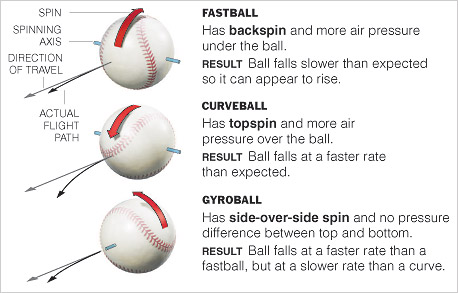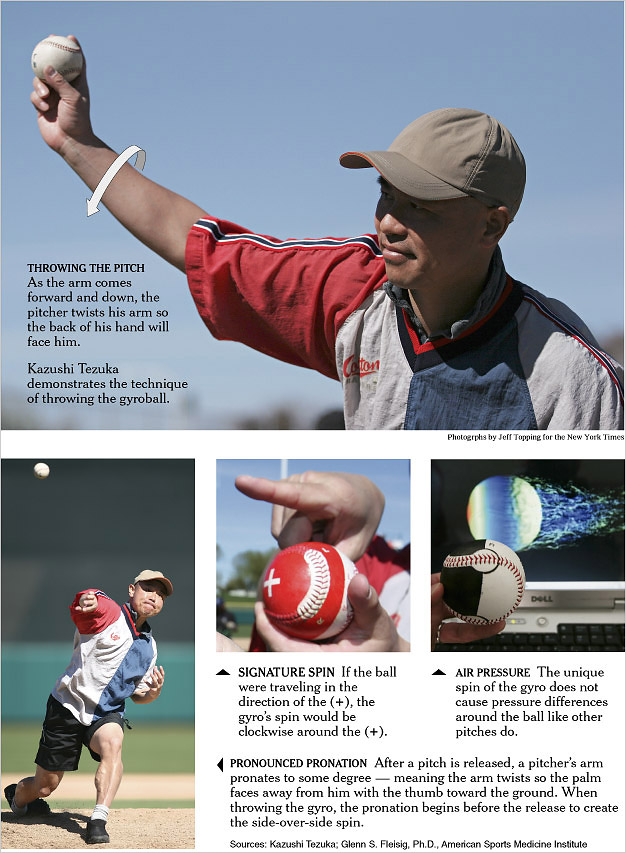By LEE JENKINS New York Times 2/22/07
SCOTTSDALE, Ariz., Feb. 21 — Most major league pitchers throw a fastball, a
curveball, a slider and a changeup. Some mix in a sinker. The experimental
ones use a knuckleball. None of them throws a gyroball, at least not on
purpose.
For most of the past decade, the gyroball seemed to exist mainly in
Japanese video games and cartoons. It was a funhouse pitch with a comic book
name.
When Japanese television analysts tried to deconstruct the mystifying
slider thrown by
Daisuke Matsuzaka, they called it a gyroball, partly because the pitch
seemed to come from another world.
Matsuzaka says he does not throw any such pitch in games — but when he
signed with the
Boston Red Sox this off-season for $52 million, American baseball fans
were forced to confront the mystery.
 Is
the gyroball a myth, or is it real? And if it is real, what exactly is it?
Is
the gyroball a myth, or is it real? And if it is real, what exactly is it?
Kazushi Tezuka 手塚一志 says he has the answer, and he flew from Japan to the United
States this week to reveal it. Tezuka, a Japanese trainer who is credited with
creating the gyroball 12 years ago, walked to the mound at Scottsdale Stadium
on Wednesday to show off his invention.
Tezuka used a standard fastball grip. He went into a basic motion. Only at
the end of his delivery did he deviate. He turned the inside of his throwing
arm away from his body and released the ball as if it were a football, making
it spiral toward home plate.
The pitch started on the same course as a changeup, but it barely dipped.
It looked like a slider, but it did not break. The gyroball, despite its zany
name, is supposed to stay perfectly straight.
“That’s it!” Tezuka said, laughing hysterically on the mound. “That’s the
gyro!”
For all of the kids who launch balls around the backyard, baseball is slow
to invent new pitches, and even slower to recognize them. The last pitch to be
adopted by major leaguers was the split-fingered fastball, about 30 years ago.
The gyroball is not going to revolutionize the sport. Like a four-seam
fastball, a four-seam gyroball is designed to surprise hitters with its speed.
Like a changeup, a two-seam gyroball is designed to fool hitters with its
slower pace.
“I think it’s basically a myth, but it’s like a lot of myths in baseball —
it can be useful,” said Robert Adair, who wrote “The Physics of Baseball.” “If
you’re a batter and you think a guy occasionally throws this pitch, it is
something extra to worry about.”
In many ways, this has been the winter of the Japanese pitcher. Matsuzaka
joined the Red Sox. Kei Igawa signed with the
Yankees. The gyroball dominated the blogosphere. Following the mania,
Tezuka was overjoyed. But he was also frustrated.
 No
one understood his pitch. It was compared to a screwball even though it is
released off a different side of the hand. It was compared to a cutter even
though it does not cut. Many American coaches claimed it was the stuff of
fantasy.
No
one understood his pitch. It was compared to a screwball even though it is
released off a different side of the hand. It was compared to a cutter even
though it does not cut. Many American coaches claimed it was the stuff of
fantasy.
So Tezuka came to spring training in Arizona this week with two baseballs
and a DVD. Standing in the
San Francisco Giants’ clubhouse on Wednesday, Tezuka watched a portion of
the DVD with one of the most unlikely viewers — outfielder
Barry Bonds.
The DVD shows Japanese pitchers throwing gyroballs and hitters from around
the world flailing at them. Usually, the hitters are either out in front of
the gyroball or slightly underneath it, expecting the pitch to sink like a
changeup.
One of the hitters on the video, undercutting the gyroball and hitting a
meager pop fly to center field, is Bonds. In 2000, during a major league tour
of Japan, Bonds swung violently at a gyroball from the sidearm pitcher Tetsuro
Kawajiri.
Studying the video in the Giants’ clubhouse Wednesday, Bonds took a moment
to try to identify the pitch. “It looks like a little slider,” he said. Asked
if it could be a gyroball, Bonds shrugged his shoulders. “I don’t know what
that is,” he said.
Tezuka came up with the gyroball in 1995, when he was given a toy known as
the X-Zylo Ultra. The toy, a flying gyroscope, could travel as far as 600 feet
when thrown with a spiral. Tezuka wondered why the motion could not work on a
baseball.
Tezuka sought out a Japanese computer scientist, Ryutaro Himeno, to test
his theory. They published a book in 2001 called “Makyuu no Shoutai.”
Translated, the title of the book means, “Secrets of the Demon Miracle Pitch.”
The gyroball has been exaggerated as often as it has been dismissed. In the
latest edition of “The Physics of Baseball,” published in 2002, Adair does not
refer specifically to the gyroball, but he does write about pitchers who try
to throw the ball with a spiral.
Usually, those pitchers are cricket bowlers.
“It’s a standard cricket pitch,” Adair said. “It’s not as useful in
baseball.”
Still, when Tezuka envisions games in 2017, he predicts that the gyroball
will be part of any pitcher’s repertoire. He estimates that 20 professional
Japanese pitchers already throw it, and 100 youths in his clinics use it. He
believes that the
Mets’
Pedro Martínez accidentally throws a pitch resembling the gyroball.
Tezuka feels so strongly about the gyroball that he has tried to get it
copyrighted. “I couldn’t get that,” he said through Masa Niwa, an interpreter.
For years, American players have warmed up their arms by throwing footballs
during batting practice. Because the gyroball is thrown like a football, it
theoretically reduces stress on the elbow and the shoulder.
Akinori Otsuka, a relief pitcher for the
Texas Rangers, works out with Tezuka in the off-season. Even though Otsuka
does not throw the gyroball, he allows his 9-year-old son to throw it. Tezuka
raves about the boy’s ability.
Tezuka visited the Rangers’ spring training complex Tuesday, mainly to see
Otsuka, but he was approached by several other pitchers. They had the same
questions everybody else does. First, they wanted to know if the gyroball is
for real.
Then, they wanted to know how to throw it.
 Jeff Topping for
the New York Times: A computer showing how the
mysterious gyroball,
allegedly thrown by Red Sox pitcher Daisuke Matsuzaka, affects
air as it moves forward.
Jeff Topping for
the New York Times: A computer showing how the
mysterious gyroball,
allegedly thrown by Red Sox pitcher Daisuke Matsuzaka, affects
air as it moves forward.
 Jeff Topping for
the New York Times: A computer showing how the
mysterious gyroball,
allegedly thrown by Red Sox pitcher Daisuke Matsuzaka, affects
air as it moves forward.
Jeff Topping for
the New York Times: A computer showing how the
mysterious gyroball,
allegedly thrown by Red Sox pitcher Daisuke Matsuzaka, affects
air as it moves forward.


 Is
the gyroball a myth, or is it real? And if it is real, what exactly is it?
Is
the gyroball a myth, or is it real? And if it is real, what exactly is it? No
one understood his pitch. It was compared to a screwball even though it is
released off a different side of the hand. It was compared to a cutter even
though it does not cut. Many American coaches claimed it was the stuff of
fantasy.
No
one understood his pitch. It was compared to a screwball even though it is
released off a different side of the hand. It was compared to a cutter even
though it does not cut. Many American coaches claimed it was the stuff of
fantasy.